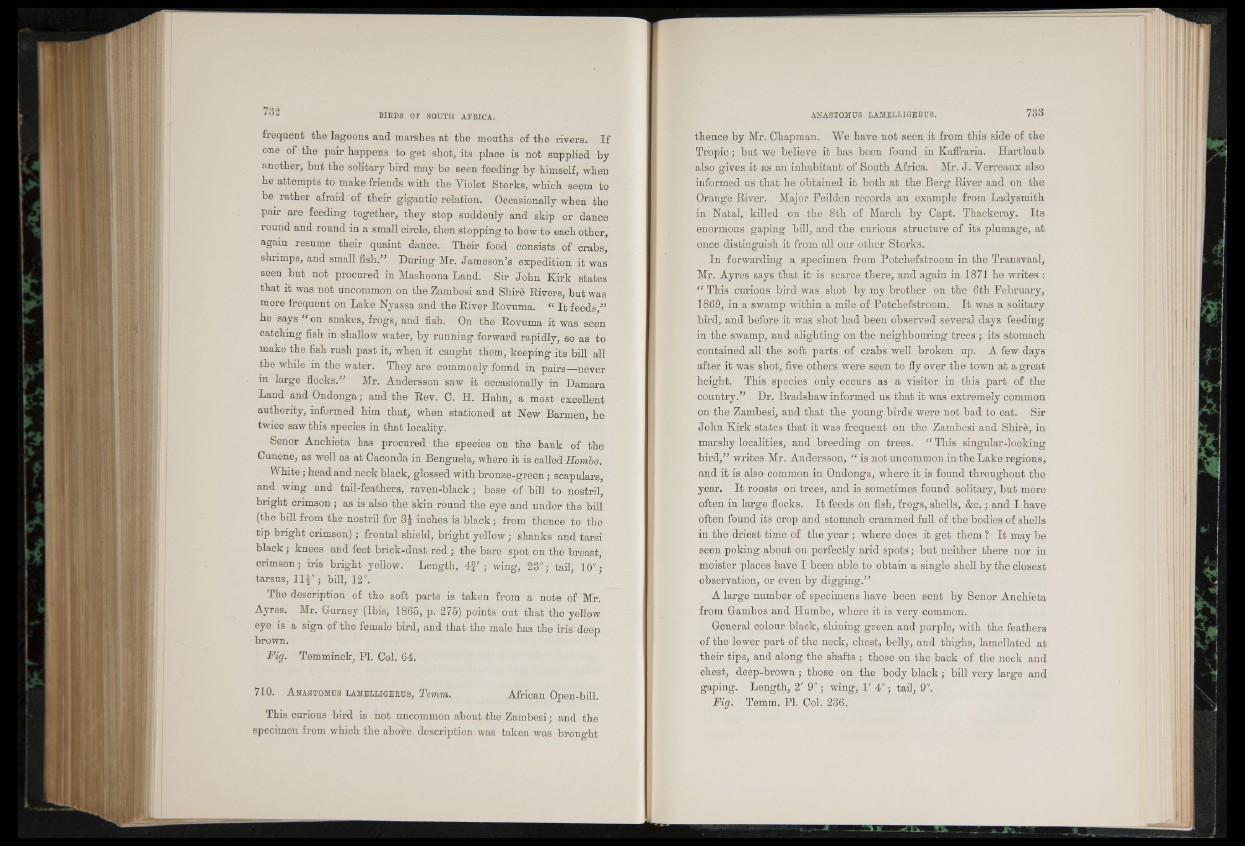
frequent the lagoons and marshes at the mouths of the rivers. If
one of the pair happens to get shot, its place is not supplied by
another, but the solitary bird may be seen feeding by himself, when
he attempts to make friends with the Yiolet Storks, which seem to
be rather afraid of their gigantic relation. Occasionally when the
pair are feeding together, they stop suddenly and skip or dance
round and round in a small circle, then stopping to bow to each other/
again resume their quaint dance. Their food consists of crabs,
shrimps, and small fish.” During Mr. Jameson's expedition it was
seen but not procured in Mashoona Land. Sir John Kirk states
that it was not uncommon on the Zambesi and Shire Rivers, but was
more frequent on Lake Nyassa and the River Rovuma. “ It feeds,”
he says “ on snakes, frogs, and fish. On the Rovuma it was seen
catching fish in shallow water, by running forward rapidly, so as to
make the fish rush past it, when it caught them, keeping its bill all
the while in the water. They are commonly found in pairs—never
in large flocks.” Mr. Andersson saw it occasionally in Damara
Land and Ondonga; and the Rev. C. H. Hahn, a most excellent
authority, informed him that, when stationed at New Barmen, he
twice saw this species in that locality.
Senor Anchieta has procured the species on the bank of the
Cunene, as well as at Caconda in Benguela, where it is called Hombo.
White; head and neck black, glossed with bronze-green; scapulars,
and wing and tail-feathers, raven-black; base of bill to nostril,
bright crimson; as is also the skin round the eye and under the bill
(the bill from the nostril for 3/ inches is black ; from thence to the
tip bright crimson); frontal shield, bright yellow ; shanks and tarsi
black; knees and feet brick-dust red ; the bare spot on the breast,
crimson; iris bright yellow. Length, 4f' ; wing, 23" ; tail, 10";
tarsus, 11 J"; bill, 12".
The description of the soft parts is taken from a note of Mr.
Ayres. Mr. Gurney (Ibis, 1865, p. 275) points out that the yellow
eye is a sign of the female bird, and that the male has the iris deep
brown.
Fig. Temminck, PI. Col. 64.
710. A nastomus lamelligerus, Temm. African Open-bill.
This curious bird is not uncommon about the Zambesi; and the
specimen from which the above description was taken was brought
ANASTOMUS LAMELLIGERUS.
thence by Mr. Chapman. We have not seen it from this side of the
Tropic; but we believe it has been found in Kaffraria. Hartlaub
also gives it as an inhabitant of South Africa. Mr. J. Yerreaux also
informed us that he obtained it both at the Berg River and on the
Orange River. Major Feilden records an example from Ladysmith
in Natal, killed on the 8th of March by Capt. Thackeray. Its
enormous gaping bill, and the curious structure of its plumage, at
once distinguish it from all our other Storks.
In forwarding a specimen from Potchefstroom in the Transvaal,
Mr. Ayres says that it is scarce there, and again in 1871 he writes :
“ This curious bird was shot by my brother on the 6th February,
1869, in a swamp within a mile of Potchefstroom. It was a solitary
bird, and before it was shot had been observed several days feeding
in the swamp, and alighting on the neighbouring trees; its stomach
contained all the soft parts of crabs well broken up. A few days
after it was shot, five others were seen to fly over the town at a great
height. This species only occurs as a visitor in this part of the
country.” Dr. Bradshaw informed us that it was extremely common
on the Zambesi, and that the young birds were not bad to eat. Sir
John Kirk states that it was frequent on the Zambesi and Shire, in
marshy localities, and breeding on trees. “ This singular-looking
bird,” writes Mr. Andersson, “ is not uncommon in the Lake regions,
and it is also common in Ondonga, where it is found throughout the
year. It roosts on trees, and is sometimes found solitary, but more
often in large flocks. It feeds on fish, frogs, shells, &c.; and I have
often found its crop and stomach crammed full of the bodies of shells
in the driest time of the year; where does it get them ? It may be
seen poking about on perfectly arid spots; but neither there nor in
moister places have I been able to obtain a single shell by the closest
observation, or even by digging.”
A large number of specimens have been sent by Senor Anchieta
from Gambos and Humbe, where it is very common.
General colour black, shining green and purple, with the feathers
of the lower part of the neck, chest, belly, and thighs, lamellated at
their tips, and along the shafts : those on the back of the neck and
chest, deep-brown; those on the body black; bill very large and
gaping. Length, 2' 9"; wing, 1' 4"; tail, 9".
Fig. Temm. PI. Col. 236.
7i